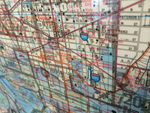In the heart of the Ghetto Nuovo, the Jewish Museum contains a small but precious collection of artifacts related to the long history of the Jews in Venice, beginning with an exhibition on Jewish festivities in the first room; chandeliers, goblets and spice-holders used to celebrate Shabbat, Shofàrs (ram’s horns) and a Séfer Torà (Scroll of Divine Law). The second room contains a rich collection of historic textiles, including Torah covers, and a rare marriage contract from 1792. A newer exhibition area explores the immigration patterns of Jews to Venice, and their experiences once here. For many the real highlight, though, is the chance to tour three of the area’s five historic synagogues (ladies must have shoulders covered and men must have heads covered; no photos): German (Scuola Grande Tedesca); Italian (Scuola Italiana), founded in 1575; Sephardic (Scuola Levantina), founded in 1541 but rebuilt in the second half of 17th century; Spanish (Scuola Spagnola), rebuilt in the first half of 17th century; and the baroque-style Ashkenazi (Scuola Canton), largely rebuilt in the 18th century. It’s difficult to predict which three you’ll visit on any given day, as it depends on which synagogues are being used (and on the whim of your guide); the Levantina and the Spanish are the most lavishly decorated, with one usually included on the tour.
Museo Ebraico di Venezia (Jewish Museum of Venice) ★ MUSEUM/SYNAGOGUE -- In the heart of the Ghetto Nuovo, the Jewish Museum contains a small but precious collection of artifacts related to the long history of the Jews in Venice, beginning with an exhibition on Jewish festivities in the first room; chandeliers, goblets, and spice-holders used to celebrate Shabbat, Shofàrs (ram’s horns) and a Séfer Torà (Scroll of Divine Law). The second room contains a rich collection of historic textiles, including Torah covers, and a rare marriage contract from 1792. A newer area explores the immigration patterns of Jews to Venice, and their experiences once here. For many, the real highlight is the chance to tour three of the area’s five historic synagogues (ladies must have shoulders covered and men must have heads covered; no photos): German (Scuola Grande Tedesca), founded in 1528; Italian (Scuola Italiana), founded in 1575; Sephardic (Scuola Levantina), founded in 1541 but rebuilt in the second half of 17th century; Spanish (Scuola Spagnola), rebuilt in the first half of 17th century; and the baroque-style Ashkenazi (Scuola Canton), largely rebuilt in the 18th century. It’s difficult to predict which three you’ll visit on any given day, as it depends on which synagogues are being used; the Levantina and the Spanish are the most lavishly decorated, with one usually included on the tour.





 About our rating system
About our rating system


